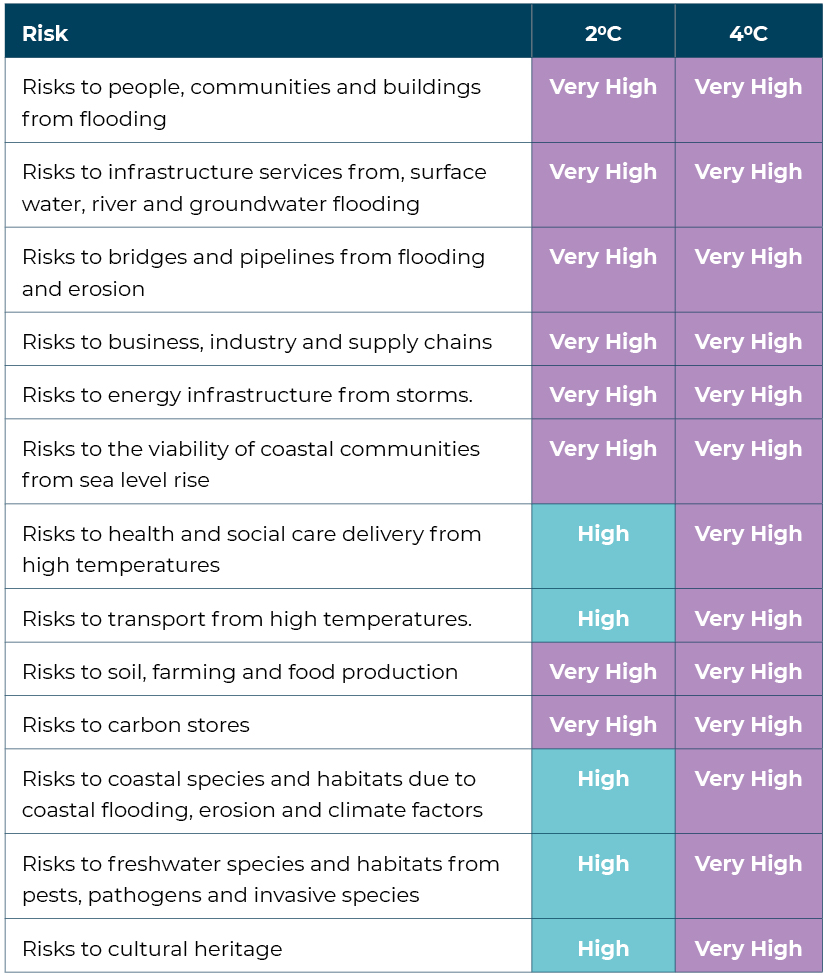
Climate Impacts
Our climate is already changing. You may have noticed changes to our temperature, rainfall, snowfall, sea level and the frequency of large storms.
These changes are already impacting our communities, infrastructure and nature. Climate change is expected to further increase these over the coming years, so we need to be prepared.
The scale of this change depends on how quickly we can bring our greenhouse gas emissions down. Some of this change is already locked in, but we are trying to limit this increase by reducing our emissions.
How is the climate expected to change in Tayside?
In Tayside we are experiencing and expecting the trend of an increased chance of warmer, wetter winters and hotter, drier summers. Although the trend is for drier summers in the future, there may be increases in the intensity of heavy summer rainfall events as well as more intense winter events.
Under a 4°C warming trajectory, Tayside may experience:
- Summer Rainfall: A decrease of 15-21% in summer rainfall could lead to drier conditions, affecting water availability and agriculture. While there will be less overall rainfall, the intensity of individual events is expected to increase.
- Winter Rainfall, Sleet and Snow: An increase of 11-15% in winter rainfall might result in wetter winters, potentially causing flooding and impacting infrastructure.
- Frost Days: An 80% reduction in frost days indicates milder winters, which could affect ecosystems and agriculture, particularly crops that rely on frost.
- Growing Degree Days: An 80% increase suggests a longer growing season, which could benefit certain crops but also increase the risk of pests and diseases.
- Heating Degree Days: A 30% decrease means less energy needed for heating, potentially reducing heating costs.
- Cooling Degree Days: An increase from 6-8 to 29-39 indicates a higher demand for cooling, which could lead to increased energy consumption and costs during hotter periods.
*Degree Days are not a number of days, but the number of degrees the daily average temperature passes the threshold, each day, added up over a year.
Across Tayside there is some significant variation in projected changes, especially between upland areas in the west and north and the flatter plains in the east. More detailed assessments are available from the Met Office Local Authority Climate Explorer.
What does this mean for me?
For Local People: People might use less energy to heat their homes in winter, saving money. But they might need to use fans or air conditioning more in summer, which could cost more. Less rain in summer might mean gardens need more watering, and wetter winters could lead to more leaks or damp problems in homes.
For a Farmer: With less rain in summer and more in winter, farmers might face dry fields during the growing season and soggy ones in winter. Fewer frost days mean some crops might not grow well, but a longer growing season could help others. However, more pests might be a problem. Farmers will need to plan carefully to protect their crops.
For a Business: Businesses might spend less on heating in winter but more on cooling in summer. Wetter winters could mean more risk of flooding, which might damage buildings and stock. Companies will need to think about how to keep their workplaces safe and comfortable for everyone.
What are the expected risks and opportunities to Tayside?
Detailed Climate Risk and Vulnerability Assessments have been completed (or are nearing completion) for each of the three Tayside local authorities. We have summarised the most significant risks identified from these in the table below looking at both 2°C and 4°C scenarios.

To see the detailed risk assessment for each local authority, please visit:
- Perth and Kinross: Climate Resilience
- Dundee: Due Summer 2025
- Angus: In progress
